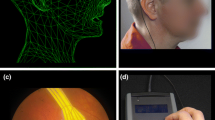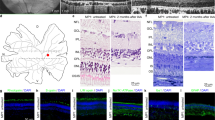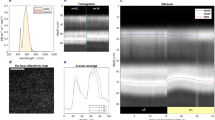Abstract
Background
Light or electromagnetic radiation may damage the neurosensory retina during irradiation of photopolymerizing resinous materials. Direct and indirect effects of irradiation emitted from polymerisation curing light may represent a severe risk factor for the eyes and the skin of the lamp operators, as well as for the patient’s oral mucosa.
Methods
Bovine superfused retinas were used to record their light-evoked electroretinogram (ERG) as ex vivo ERGs. Both the a- and the b-waves were used as indicators for retinal damage on the functional level. The isolated retinas were routinely superfused with a standard nutrient solution under normoglycemic conditions (5 mM D-glucose). The change in the a- and b-wave amplitude and implicit time, caused by low and high intensity irradiation, was calculated and followed over time.
Results
From the results, it can be deduced that the irradiation from LED high-power lamps affects severely the normal physiological function of the bovine retina. Irradiations of 1,200 lx irreversibly damaged the physiological response. In part, this may be reversible at lower intensities, but curing without using the appropriate filter will bleach the retinal rhodopsin to a large extent within 20 to 40 s of standard application times.
Conclusion
Constant exposure to intense ambient irradiation affects phototransduction (a-wave) as well as transretinal signalling. The proper use of the UV- and blue-light filtering device is highly recommended, and may prevent acute and long lasting damage of the neurosensory retina.






Similar content being viewed by others
References
Youssef PN, Sheibani N, Albert DM (2011) Retinal light toxicity. Eye (Lond) 25:1–14
Diffey BL (2002) Sources and measurement of ultraviolet radiation. Methods 28:4–13
Roberts JE (2011) Ultraviolet radiation as a risk factor for cataract and macular degeneration. Eye Contact Lens 37:246–249
Malik S, Rani S, Kumar V (2004) Wavelength dependency of light-induced effects on photoperiodic clock in the migratory blackheaded bunting (Emberiza melanocephala). Chronobiol Int 21:367–384
Chalam KV, Khetpal V, Rusovici R, Balaiya S (2011) A review: role of ultraviolet radiation in age-related macular degeneration. Eye Contact Lens 37:225–232
Organisciak DT, Vaughan DK (2010) Retinal light damage: mechanisms and protection. Prog Retin Eye Res 29:113–134
Bruzell Roll EM, Jacobsen N, Hensten-Pettersen A (2004) Health hazards associated with curing light in the dental clinic. Clin Oral Investig 8:113–117
Lüke M, Lüke C, Hescheler J, Schneider T, Sickel W (2005) Effects of phosphodiesterase type 5 inhibitor sildenafil on retinal function in isolated superfused retina. J Ocul Pharmacol Ther 21:305–314
Lüke M, Weiergräber M, Brand C, Siapich SA, Banat M, Hescheler J, Lüke C, Schneider T (2005) The isolated perfused bovine retina—a sensitive tool for pharmacological research on retinal function. Brain Res Brain Res Protocols 16:27–36
Quinones-Hinojosa A, Malek JY, Ames A III, Ogilvy CS, Maynard KI (2003) Metabolic effects of hypothermia and its neuroprotective effects on the recovery of metabolic and electrophysiological function in the ischemic retina in vitro. Neurosurgery 52:1178–1186
Hanawa I, Tateishi T (1970) The effect of aspartate on the electroretinogram of the vertebrate retina. Experientia 26:1311–1312
Castelnuovo J, Tjan AH (1997) Temperature rise in pulpal chamber during fabrication of provisional resinous crowns. J Prosthet Dent 78:441–446
Baroudi K, Silikas N, Watts DC (2009) In vitro pulp chamber temperature rise from irradiation and exotherm of flowable composites. Int J Paediatr Dent 19:48–54
Karaarslan ES, Secilmis A, Bulbul M, Yildirim C, Usumez A (2011) Temperature increase beneath etched dentin discs during composite polymerization. Photomed Laser Surg 29:47–52
Onisor I, Asmussen E, Krejci I (2011) Temperature rise during photo-polymerization for onlay luting. Am J Dent 24:250–256
Wu J, Seregard S, Algvere PV (2006) Photochemical damage of the retina. Surv Ophthalmol 51:461–481
Boulton M, Rozanowska M, Rozanowski B (2001) Retinal photodamage. J Photochem Photobiol B 64:144–161
Baumann C (1972) The regeneration and renewal of visual pigment in vertebrates. In: Dartnall HJA (ed) Handbook of sensory physiology. Springer, Berlin, Heidelberg, New York
Azuma K, Azuma M, Sickel W (1977) Regeneration of rhodopsin in frog rod outer segments. J Physiol 271:747–759
Ewald A, Kühne W (1878) Untersuchungen über den Sehpurpur. II. Die Entstehung der Retinafarbe. Unters Physiol Inst Heidelb 1:248–290
Acknowledgments
We thank Ms. Renate Clemens for her permanent technical assistance, and Mr. Maximilian Thelen as well as Ms. Valentina Safronjuk for help during retina preparations. The work was financially supported by the Köln Fortune Program/Faculty of Medicine, University of Köln (to TS).
Author information
Authors and Affiliations
Corresponding author
Additional information
Matthias Lüke and Toni Schneider shared senior authorship.
Rights and permissions
About this article
Cite this article
Rassaei, M., Thelen, M., Abumuaileq, R. et al. Effect of high-intensity irradiation from dental photopolymerization on the isolated and superfused vertebrate retina. Graefes Arch Clin Exp Ophthalmol 251, 751–762 (2013). https://doi.org/10.1007/s00417-012-2235-x
Received:
Revised:
Accepted:
Published:
Issue Date:
DOI: https://doi.org/10.1007/s00417-012-2235-x




